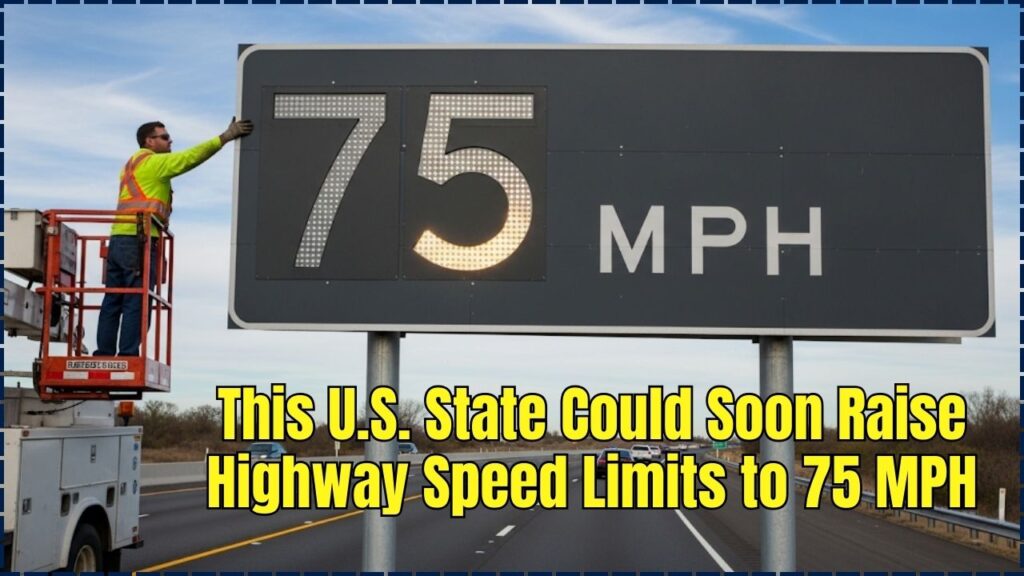If you’ve been cruising down Florida’s highways lately, you might’ve noticed something: plenty of folks are already pushing past that 70 MPH sign like it’s a polite suggestion. Now, lawmakers are talking about making that speed official, raising the highway speed limit to 75 MPH in some parts of the Sunshine State.

But this isn’t just about getting to Disney or Miami Beach a little faster. This move ties into safety studies, engineering realities, national trends, and yes — a bit of politics too.
U.S. State Could Soon Raise Highway Speed
| Detail | Info |
|---|---|
| State | Florida |
| Proposed Change | Interstate & turnpike speed limits from 70 → 75 MPH; rural divided highways from 65 → 70 MPH |
| Legislation | Senate Bill 462 / House Bill 567 |
| Why Now? | Align with 17+ other states, reflect real driving habits |
| Safety Study | Florida DOT (FDOT) required to review before implementation |
| Concerns | Increased crash severity, possible rise in fatalities |
| Potential Start Date | July 1 (if passed & approved by FDOT) |
| Official Resource | Florida Department of Transportation |
Florida’s possible move to raise highway speed limits to 75 MPH blends public demand with engineering analysis and safety research. Supporters call it common sense, while critics warn it could lead to more deadly crashes. The final call will rest with FDOT’s study — and how the state balances speed with safety.
Why Florida Wants to Raise the Speed Limit
Florida’s roads are long, flat, and built for high-capacity travel. Supporters of the bill, like Senator Nick DiCeglie, argue that the current 70 MPH limit is outdated and doesn’t match the pace of actual traffic flow. They point to 17 other states — including Texas, Utah, and South Dakota — where 75+ MPH is already legal.
The thinking goes: when speed limits better reflect how people actually drive, you reduce speed differences between vehicles, which in turn can reduce weaving, tailgating, and risky passing.
A Look Back: How Speed Limits Got Here
For younger readers, here’s a quick history lesson.
- 1974 — The U.S. set a nationwide 55 MPH limit in response to the oil crisis.
- 1995 — Congress returned speed control to the states, and limits began climbing.
- Today — Some rural roads in Texas are posted at 85 MPH, the highest in the nation.
Florida last raised its top limit in the 1990s, moving from 65 to 70 MPH on interstates.
Safety Concerns and the Data
The Insurance Institute for Highway Safety (IIHS) warns that raising limits by just 5 MPH can lead to an 8.5% increase in fatalities on freeways.
AAA and some law enforcement groups worry that faster posted speeds will encourage even higher driving speeds, especially in rural areas where emergency medical response times can be longer.
FDOT will conduct a full engineering and safety study before approving any changes — and they can exclude specific stretches of road if needed.
Economic Impact: More Than Just Minutes Saved
- Trucking & Shipping — Higher limits could improve delivery times for freight operators, but may also increase fuel costs.
- Tourism — Quicker drives could make it easier for visitors to explore multiple cities in one trip.
- Fuel Economy — According to the U.S. Department of Energy, fuel efficiency drops significantly above 50 MPH, so drivers could see higher gas bills.
Engineering Perspective: Why Some Roads Can Handle More Speed
Road designers look at lane width, shoulder size, sight distance, and curve sharpness before approving higher speeds.
- Wide, straight interstates with good visibility can safely handle more speed.
- Older highways with tight curves, narrow shoulders, or poor lighting might be kept at lower limits.
Case Studies: Other States That Raised Limits
- Utah — Increased from 75 to 80 MPH on rural interstates with no major spike in crashes, according to state data.
- Montana — Briefly had no daytime limit in the late ’90s; now posted at 80 MPH, with mixed public opinion.
- Texas — The 85 MPH stretch of SH 130 is loved by long-haul drivers but criticized by some safety advocates.
What Happens If It Passes?
- Legislature Approves Bill — Both chambers must agree.
- Governor Signs — Becomes law.
- FDOT Study — Determines which roads qualify.
- Signage Updates — New speed limit signs installed.
- Public Campaign — FDOT educates drivers on the change.
Earliest possible start: July 1.
Myths About Higher Speed Limits debunked Myth
- Myth: Higher speed limits automatically mean everyone will drive much faster. * Fact: Studies show that when a speed limit is raised, the average traffic speed usually increases by only a small amount—often just a few miles per hour. People tend to drive at a speed they feel is safe for the conditions, regardless of the sign.
- Myth: Raising the speed limit will lead to a massive increase in accidents.
- Fact: While some studies link higher speeds to more severe crashes, the most significant danger often comes from drivers traveling at widely different speeds, not just fast speeds alone. Uniform traffic flow can be safer.
Public Opinion Snapshot
Local TV station polls show a split:
- ~55% support the increase, saying it reflects “how people already drive.”
- ~40% oppose, citing safety concerns.
- 5% are undecided.
Comparing Speed Limits: Then and Now
| Feature | Pre-1974 National Limit | Today (Post-1995) |
| Max Speed | 55 mph | Varies by state; up to 85 mph |
| Why it was set | Fuel conservation during the oil crisis | Traffic engineering and safety studies |
| Authority | Federal government (via the National Maximum Speed Law) | Individual states |
| Driving experience | Uniformly slower across the country | Significant variation when crossing state lines |
Practical Tips for Driving at Higher Speeds
1. Keep More Distance
At 75 MPH, you cover 110 feet per second — leave extra space.
2. Scan Ahead
Look beyond the car in front of you to anticipate slowdowns.
3. Use the Right Lane
Unless passing, stick right to avoid road rage and unsafe weaving.
4. Don’t Mix Distractions
Texting at 75 MPH is like driving blind for the length of a football field.
FAQs
Q1: Will all Florida highways change to 75 MPH?
A: No, FDOT will approve only those deemed safe.
Q2: How much time will this save?
A: About 6–7 minutes per 100 miles — if traffic is steady.
Q3: Is this change permanent?
A: Laws can be revised if crash data shows increased danger.
Q4: What about speed enforcement?
A: Police may shift focus to aggressive driving rather than small overages.
Q5: Will my insurance go up?
A: Not directly from the law, but higher crash rates in an area can influence premiums.








